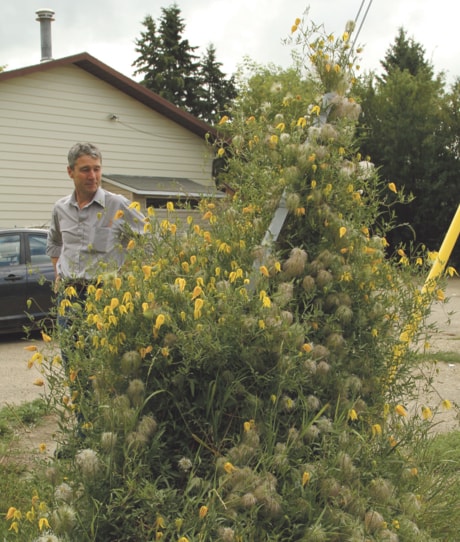Native habitat is being threatened by invading weeds because the City of Red Deer fails to take any preventive measures, says a Red Deer naturalist.
Tony Blake said he believes the city isn’t doing enough to prevent exotic species from spreading through areas where native species live. Blake was initially alarmed six years ago when he saw Cicer milkvetch, a perennial legume introduced to North America from Europe, outside the Kerry Wood Nature Centre. He found a large presence of it, smothering native vegetation within the Gaetz Lakes Sanctuary.
“It’s kind of disturbing when you have been led to believe this is our crown jewel, our best example of native vegetation,” Blake said. “The nature centre is basically ground zero (for this weed). It will grow quite happily in turf and will keep spreading through the roots.”
Blake said he’s seen other weed problems as well.
“The city should concentrate more on preventing new weeds like Himalayan impatiens and burdock — things we don’t have but we know are coming,” he said.
He’s particularly concerned with purple loosestrife, which he has seen on the outskirts of Red Deer. The city appears to confuse weed control with weed prevention, he said.
“Prevention is the only thing we can afford. Control is basically hopeless for a lot of weeds.”
Blake referred to a recent email from a civic employee who said “it is the city’s responsibility to focus first on eliminating or controlling those noxious weeds in the (provincial) Weed Act that are widely spread, such as Canada thistle and scentless chamomile.” The employee also notes the city does control small numbers of invasive species.
“An infestation of invasive species is like a fire in slow motion,” Blake said. “They do real damage over time.”
Parks superintendent Trevor Poth said the city has a weed inspector who looks out for prohibited noxious or noxious weeds as listed under the provincial Weed Control Act.
If they are found, they are treated. Sometimes they are mowed down, as is the case with Canada thistle.
“There is legislation in place that we need to control and manage,” Poth said.
Invasive species tend to spread, but are more than likely not identified in the Weed Act so there aren’t any mandatory controls put in place.
“Unfortunately, we’ve never had much funding to manage these weeds,” Poth said. “We focus on the legislated controls prescribed by the province.”
Funding for weed control has remained static in recent years, he added.
Blake, a member of the Red Deer River Naturalists, should be commended for being watchful of city parks, Poth added.
“He’s great at identifying areas that he feels need additional effort,” Poth said. “We do what we can to maintain service levels, sometimes the expectation is we can do it all. But we have to be fiscally responsible as well as being ecologically sensitive.”
In June, a new Weed Control Act was proclaimed. It consolidates regulations for a more streamlined and comprehensive approach. Paul Laflamme, head of pest surveillance for Alberta Agriculture and Rural Development, said the act didn’t change much from its last review 20 years ago. The act has been around since 1907.
He said Cicer milkvetch isn’t listed in the act as a weed but is described as a forage crop, so the city doesn’t have to do anything about it.
“Purple loosestrife is a prohibited noxious weed and should be destroyed as soon as it is found,” Laflamme said. “We’d certainly like to know where (Blake) has seen it.”
If a municipality isn’t doing its job, the province can step in and charge back any expenses to the municipality, Laflamme said.
There are 46 plants on the prohibited noxious weed list (not found or rarely found in Alberta), and 29 plants on the noxious weeds category (more readily found in Alberta, but remain of concern because they can spread easily and cause problems for producers). Dandelions are not listed because they are way too common and are thus hard to see any controls enforced, Laflamme said.
For more information on weeds, go online at www.agric.gov.ab.ca
ltester@www.reddeeradvocate.com
